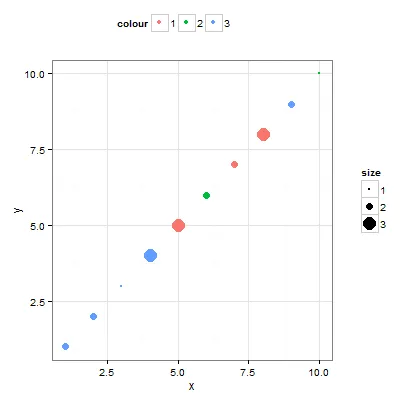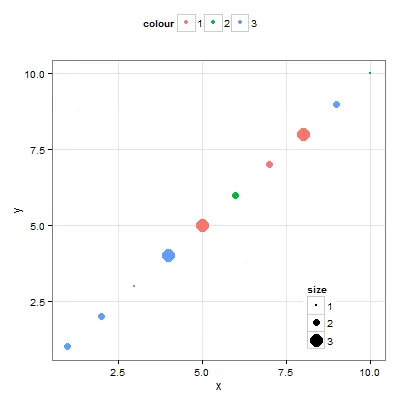标题已经很好地概括了问题。
我有两个图例,一个是有关大小的,一个是有关颜色的,并希望将一个放在顶部,另一个放在图表内部。
是否可行,如果可以,请问如何实现?
谢谢您的帮助。
标题已经很好地概括了问题。
我有两个图例,一个是有关大小的,一个是有关颜色的,并希望将一个放在顶部,另一个放在图表内部。
是否可行,如果可以,请问如何实现?
谢谢您的帮助。
可以通过从图表中提取单独的图例,然后将这些图例排列在相关的图表中来完成。此处的代码使用 gtable 包中的函数进行提取,然后使用 gridExtra 包中的函数进行排列。目标是拥有一个包含颜色图例和大小图例的图表。首先,从仅包含颜色图例的图表中提取颜色图例。其次,从仅包含大小图例的图表中提取大小图例。第三,绘制一个不包含图例的图表。第四,将图表和两个图例排列在一起形成一个新的图表。
# Some data
df <- data.frame(
x = 1:10,
y = 1:10,
colour = factor(sample(1:3, 10, replace = TRUE)),
size = factor(sample(1:3, 10, replace = TRUE)))
library(ggplot2)
library(gridExtra)
library(gtable)
library(grid)
### Step 1
# Draw a plot with the colour legend
(p1 <- ggplot(data = df, aes(x=x, y=y)) +
geom_point(aes(colour = colour)) +
theme_bw() +
theme(legend.position = "top"))
# Extract the colour legend - leg1
leg1 <- gtable_filter(ggplot_gtable(ggplot_build(p1)), "guide-box")
### Step 2
# Draw a plot with the size legend
(p2 <- ggplot(data = df, aes(x=x, y=y)) +
geom_point(aes(size = size)) +
theme_bw())
# Extract the size legend - leg2
leg2 <- gtable_filter(ggplot_gtable(ggplot_build(p2)), "guide-box")
# Step 3
# Draw a plot with no legends - plot
(plot <- ggplot(data = df, aes(x=x, y=y)) +
geom_point(aes(size = size, colour = colour)) +
theme_bw() +
theme(legend.position = "none"))
### Step 4
# Arrange the three components (plot, leg1, leg2)
# The two legends are positioned outside the plot:
# one at the top and the other to the side.
plotNew <- arrangeGrob(leg1, plot,
heights = unit.c(leg1$height, unit(1, "npc") - leg1$height), ncol = 1)
plotNew <- arrangeGrob(plotNew, leg2,
widths = unit.c(unit(1, "npc") - leg2$width, leg2$width), nrow = 1)
grid.newpage()
grid.draw(plotNew)
# OR, arrange one legend at the top and the other inside the plot.
plotNew <- plot +
annotation_custom(grob = leg2, xmin = 7, xmax = 10, ymin = 0, ymax = 4)
plotNew <- arrangeGrob(leg1, plotNew,
heights = unit.c(leg1$height, unit(1, "npc") - leg1$height), ncol = 1)
grid.newpage()
grid.draw(plotNew)


arrangeGrob中使用heights参数的逻辑吗?例如,在plotNew <- arrangeGrob(leg1, plot, heights = unit.c(leg1$height, unit(1, "npc") - leg1$height), ncol = 1)中。我知道heights作为参数传递给了grid.layout,但我很难看出它在这里的用法。谢谢。 - Faheem Mithaannotation_custom,我可以定位多个表格、文本、线条、矩形等,但无法定位多个图形。我的解决方法是使用视口(viewports),并改编自 http://stackoverflow.com/questions/10539376/10539376。 - Sandy Muspratt使用 ggplot2 和 cowplot(= ggplot2扩展)。
这种方法与Sandy的方法类似,它将图例作为单独的对象提取出来,并让您可以独立地进行放置。它主要设计用于属于网格中两个或多个绘图的多个图例。
思路如下:
看起来有点复杂和耗费时间/代码,但是只需设置一次,您就可以适应并将其用于各种类型的绘图/图例自定义。
library(ggplot2)
library(cowplot)
# Some data
df <- data.frame(
Name = factor(rep(c("A", "B", "C"), 12)),
Month = factor(rep(1:12, each = 3)),
Temp = sample(0:40, 12),
Precip = sample(50:400, 12)
)
# 1. create plot1
plot1 <- ggplot(df, aes(Month, Temp, fill = Name)) +
geom_point(
show.legend = F, aes(group = Name, colour = Name),
size = 3, shape = 17
) +
geom_smooth(
method = "loess", se = F,
aes(group = Name, colour = Name),
show.legend = F, size = 0.5, linetype = "dashed"
)
# 2. create plot2
plot2 <- ggplot(df, aes(Month, Precip, fill = Name)) +
geom_bar(stat = "identity", position = "dodge", show.legend = F) +
geom_smooth(
method = "loess", se = F,
aes(group = Name, colour = Name),
show.legend = F, size = 1, linetype = "dashed"
) +
scale_fill_grey()
# 3.1 create legend1
legend1 <- ggplot(df, aes(Month, Temp)) +
geom_point(
show.legend = T, aes(group = Name, colour = Name),
size = 3, shape = 17
) +
geom_smooth(
method = "loess", se = F, aes(group = Name, colour = Name),
show.legend = T, size = 0.5, linetype = "dashed"
) +
labs(colour = "Station") +
theme(
legend.text = element_text(size = 8),
legend.title = element_text(
face = "italic",
angle = -0, size = 10
)
)
# 3.2 create legend2
legend2 <- ggplot(df, aes(Month, Precip, fill = Name)) +
geom_bar(stat = "identity", position = "dodge", show.legend = T) +
scale_fill_grey() +
guides(
fill =
guide_legend(
title = "",
title.theme = element_text(
face = "italic",
angle = -0, size = 10
)
)
) +
theme(legend.text = element_text(size = 8))
# 3.3 extract "legends only" from ggplot object
legend1 <- get_legend(legend1)
legend2 <- get_legend(legend2)
# 4.1 setup legends grid
legend1_grid <- cowplot::plot_grid(legend1, align = "v", nrow = 2)
# 4.2 add second legend to grid, specifying its location
legends <- legend1_grid +
ggplot2::annotation_custom(
grob = legend2,
xmin = 0.5, xmax = 0.5, ymin = 0.55, ymax = 0.55
)
# 5. plot "plots" + "legends" (with legends in between plots)
cowplot::plot_grid(plot1, legends, plot2,
ncol = 3,
rel_widths = c(0.45, 0.1, 0.45)
)

这是由reprex package(v0.3.0)于2019年10月5日创建的。
将最后一个 plot_grid() 的调用顺序改变可以将图例移动到右侧:
cowplot::plot_grid(plot1, plot2, legends, ncol = 3,
rel_widths = c(0.45, 0.45, 0.1))
ggplot2中对图例的控制非常有限。以下是Hadley的书中的一段话(第111页):